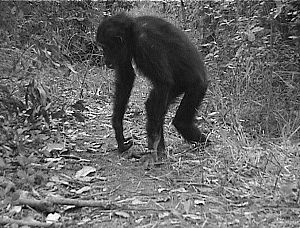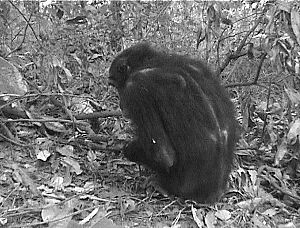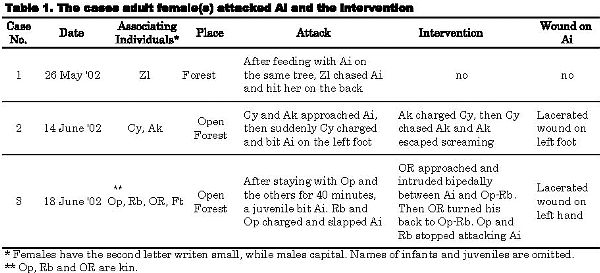|
Chimpanzee Attitude toward a Seriously Weakened Adolescent Female at Mahale
Masaki Shimada, Kyoto University Mosi Matumula, Mahale Mts. Chimpanzee Research Project Ai, a young adult female chimpanzee of the M group, became weak gradually and disappeared after 3 years. de Waal (1) and Goodall (2) reported that some chimpanzees become "anxious" about seriously wounded or disabled individuals, and that the other chimpanzees were "fearful" of or "antagonistic" to them.
In this report, we focus on the change in Ai's health condition and whether the types of interactions reported by previous authors were also observed in Ai's case. We discuss the unique features of this interaction, including observations of Ai just before she became lost, based on data sampled by focal animal sampling and ad lib sampling methods. Ai had been gradually weakening over the course of three years. However, until February 2002, Ai was observed to slowly follow the other chimpanzees forming large cohesive parties and sometimes even to play with the others.
After she was missing for four months, we encountered Ai again on May 26, 2002 and found that she frequently stumbled over the ground and could barely walk (Figure 1). The last observation of Ai was on June 29, 2002, and she seemed so sick that she could hardly walk straight. In the 11 associating events, we observed no individuals behaving "fearfully" to Ai (grin, full embrace, or avoid), while some adult female(s) behaved "antagonistically" (attack) in three events. Ai had her old mother and senior brother, and they and other individuals behaved "anxiously" to Ai (care, pat or share food), except for the cases where females showed aggression toward Ai.
In two out of the three events when female(s) attacked Ai, non-kin individuals intervened against these attacks, consequently stopping them (Table 1). In June 2002, plenty of fallen fruits of Parinari curatellifolia were found on the ground in limited parts of the southern open forest. Ai was staying alone under Parinari trees and crawled within a small area to feed on the fruits on the ground almost everyday, since it seemed already difficult for Ai to walk to another food tree or to climb up trees to feed. Compared with the cases reported by previous authors (1, 2), the unique features of Ai's case are, first, that females rather than males bullied Ai just before she was lost, and, second, that non-kin individuals rather than kin intervened against these attacks by females. It is known that among female chimpanzees the frequency of aggressive interaction is very low and that bullying seldom occurs (2, 4). Nevertheless, attacks against Ai happened at least three times over 12 days, and Ai suffered wounds twice by the attackers. Because Ai did not suffer attacks by females when she was comparatively healthier, some females became "antagonistic" to Ai only after she had become seriously weakened. Two cases of intervention by non-kin individuals were newly observed. They took high risks to support Ai: In case 2, Cy's rank was higher than Ak's, and in case 3, OR intruded alone against two attackers, Op (OR's mother) and Rb (OR's sister). OR intervened "neutrally" in a non-aggressive way by turning his back to the attackers (Table 1). As a result, he succeeded in stopping the attack without suffering any attack by his mother or sister. This may be a good example of chimpanzees' high cognitive capacity for solving social problems. The field study was financially supported by a MEXT Grant-in-Aid for Scientific Research (Basic Research A1, #12375003 to T. Nishida).
Back to Contents |


